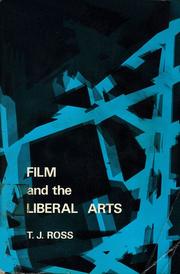
Film and the liberal arts
By Ross, T. J.
Subjects: Humanistic Education, Motion pictures in education
Description: Film plays a dominant role in our culture. The intensive discussions aroused in recent years by outstanding films, ranging from Breathless to Bonnie and Clyde, from La Dolce Vita to 2001, from A Hard Day's Night to The Graduate, attest to the extent to which film—more than any of the other media—touches home; it reaches us all. On the campus, there has developed an increasingly vital and inquiring interest in film, an interest held in common by teachers and students. This means that film as a subject lends itself to immediate and engaged discussion, to a ready sharing and exchange between teacher and student of viewpoints and tastes and expectations. Since film is a medium which partakes of all the more traditional arts, revealing special kinships with literature, with the visual arts, and with music, it lends itself to a purview which bridges over into these areas, and into allied liberal arts areas like rhetoric, sociology, and psychology. The advantage to the student of an orientation keyed to the multiple nature of the cinema, such as this book offers, is that it also introduces him to the multiple concerns and possibilities of communications and culture in general. And the teacher is provided with various approaches from a central base for class discussion and writing. The essays in this book use film as a common core, but not in isolation. Rather, each set of essays revolves around film and one or more of the liberal arts: first, film and rhetoric, to highlight the special language of film, its mode of communication; then an extensive section on film and literature followed by briefer ones on film and the visual arts, and film and music, to examine the elements film shares with each of these forms; the next section on film and society offers in-depth appraisals of the cinema in its response to, and presentation of, social styles and values; a final section on film and esthetics considers aspects of the film-making process as these relate to evaluation of film and its achievement as an art form. This in overview is the sequence of the book; the topics of each section, however, are self-contained and may be taken up and used in any order. Each essay is followed by three types of exercises: exercises on the content of the essay; exercises which invite the reader to compare his own film experience with that of the essayist under consideration; and exercises on the essay's structure and language as guides to discussion of effective writing. An appendix at the end of the volume lists a number of films related to the section topics and the distributing companies through which they may be obtained. A selected bibliography is also included. Although a number of the selections are of manifest topical appeal, I have sought articles written from a point of view which has proved to be, or seems likely to be, of continuing pertinence. In line with this, I have favored writing whose implication and argument can be readily followed whether or not one is directly familiar with the work which served as the author's point of departure. Further, to provide a basis for independent opinion and response I have in several instances brought together contrasting, as well as cognate, views on the same topic. Ranging in tone and style from the breezy to the earnest, from the poetically evocative to the toughly analytical, the essays present a variety of modes of lively and graceful prose. They also exemplify—like any educational experience of value—the varying degrees of pressure and judgment which can be brought to bear on a given topic. In the preparation of this volume, I owe special thanks to Phillip Leininger for his steady editorial help and encouragement. Madison, New Jersey December 1960 T.J.R.
Comments
You must log in to leave comments.